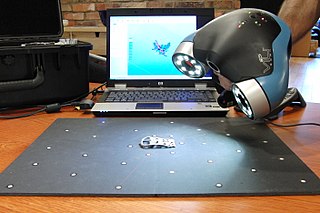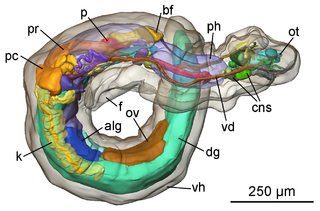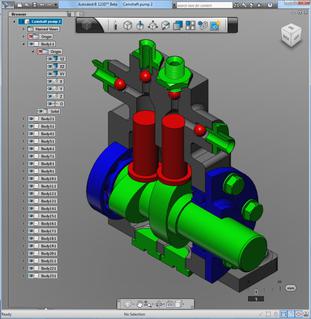
Digital sculpting, also known as sculpt modeling or 3D sculpting, is the use of software that offers tools to push, pull, smooth, grab, pinch or otherwise manipulate a digital object as if it were made of a real-life substance such as clay.

Digital sculpting, also known as sculpt modeling or 3D sculpting, is the use of software that offers tools to push, pull, smooth, grab, pinch or otherwise manipulate a digital object as if it were made of a real-life substance such as clay.
The geometry used in digital sculpting programs to represent the model can vary; each offers different benefits and limitations. The majority of digital sculpting tools on the market use mesh-based geometry, in which an object is represented by an interconnected surface mesh of polygons that can be pushed and pulled around. This is somewhat similar to the physical process of beating copper plates to sculpt a scene in relief. Other digital sculpting tools use voxel-based geometry, in which the volume of the object is the basic element. Material can be added and removed, much like sculpting in clay. Still other tools make use of more than one basic geometry representation.
A benefit of mesh-based programs is that they support sculpting at multiple resolutions on a single model. Areas of the model that are finely detailed can have very small polygons while other areas can have larger polygons. In many mesh-based programs, the mesh can be edited at different levels of detail, and the changes at one level will propagate to higher and lower levels of model detail. A limitation of mesh-based sculpting is the fixed topology of the mesh; the specific arrangement of the polygons can limit the ways in which detail can be added or manipulated.
A benefit of voxel-based sculpting is that voxels allow complete freedom over form. The topology of a model can be altered continually during the sculpting process as material is added and subtracted, which frees the sculptor from considering the layout of polygons on the model's surface. After sculpting, it may be necessary to retopologize the model to obtain a clean mesh for use in animation or real-time rendering. Voxels, however, are more limited in handling multiple levels of detail. Unlike mesh-based modeling, broad changes made to voxels at a low level of detail may completely destroy finer details.
Sculpting can often introduce details to meshes that would otherwise have been difficult or impossible to create using traditional 3D modeling techniques. This makes it preferable for achieving photorealistic and hyperrealistic results, though, many stylized results are achieved as well.
Sculpting is primarily used in high poly organic modeling (the creation of 3D models which consist mainly of curves or irregular surfaces, as opposed to hard surface modeling). [1] It is also used by auto manufacturers in their design of new cars. [2] [3] [4]
It can create the source meshes for low poly game models used in video games. In conjunction with other 3D modeling and texturing techniques and Displacement and Normal mapping, it can greatly enhance the appearance of game meshes often to the point of photorealism. Some sculpting programs like 3D-Coat, Zbrush, and Mudbox offer ways to integrate their workflows with traditional 3D modeling and rendering programs. Conversely, 3D modeling applications like 3ds Max, Maya and MODO are now incorporating sculpting capability as well, though these are usually less advanced than tools found in sculpting-specific applications.

High poly sculpts are also extensively used in CG artwork for movies, industrial design, art, photorealistic illustrations, and for prototyping in 3D printing.
Virtual clothes are digital garments used for video game characters (avatars / 3D models), in animation films and commercials, and as clothing for digital doubles in films such as "The Hobbit", for dangerous scenes or when it is simply impossible to use a real-life actor. Virtual clothing is commonly also used for dressing up a player's avatar in a virtual world game as well as for making selling virtual clothes in 3D marketplaces like Second Life. Additional uses for digital clothes is for VR and AI technologies, online shop catalogs of fashion retailers, and scene of crime recreation purposes.

Sculptors and digital artists use digital sculpting to create a model (or Digital Twin) to be materialized through CNC technologies including 3D printing. The final sculptures are often called Digital Sculpture or 3D printed art. While digital technologies have emerged in many art disciplines (painting, photography), this is less the case for digital sculpture due to the higher complexity and technology limitations to produce the final sculpture.
The best way to learn sculpture is by understanding primary, secondary and tertiary forms. First, break down the object you want to make down its basic shapes, such as a sphere or cube. Focus on making the large, overall shape of the object. After that, work on the bigger shapes on top of or inside the object. These can be protrusions or cut outs. Then, do a final detail pass, such as pores or lines to break up the shape.
There are a number of digital sculpting tools available. Some popular tools for creating are:
Traditional 3D modeling suites are also beginning to include sculpting capability. [5] 3D modeling programs which currently feature some form of sculpting include the following:

Computer-aided design (CAD) is the use of computers to aid in the creation, modification, analysis, or optimization of a design. This software is used to increase the productivity of the designer, improve the quality of design, improve communications through documentation, and to create a database for manufacturing. Designs made through CAD software help protect products and inventions when used in patent applications. CAD output is often in the form of electronic files for print, machining, or other manufacturing operations. The terms computer-aided drafting (CAD) and computer-aided design and drafting (CADD) are also used.
Autodesk 3ds Max, formerly 3D Studio and 3D Studio Max, is a professional 3D computer graphics program for making 3D animations, models, games and images. It is developed and produced by Autodesk Media and Entertainment. It has modeling capabilities and a flexible plugin architecture and must be used on the Microsoft Windows platform. It is frequently used by video game developers, many TV commercial studios, and architectural visualization studios. It is also used for movie effects and movie pre-visualization. 3ds Max features shaders, dynamic simulation, particle systems, radiosity, normal map creation and rendering, global illumination, a customizable user interface, and its own scripting language.

Constructive solid geometry is a technique used in solid modeling. Constructive solid geometry allows a modeler to create a complex surface or object by using Boolean operators to combine simpler objects, potentially generating visually complex objects by combining a few primitive ones.
LightWave 3D is a 3D computer graphics program developed by LightWave Digital. It has been used in films, television, motion graphics, digital matte painting, visual effects, video game development, product design, architectural visualizations, virtual production, music videos, pre-visualizations and advertising.
In computer graphics, level of detail (LOD) refers to the complexity of a 3D model representation. LOD can be decreased as the model moves away from the viewer or according to other metrics such as object importance, viewpoint-relative speed or position. LOD techniques increase the efficiency of rendering by decreasing the workload on graphics pipeline stages, usually vertex transformations. The reduced visual quality of the model is often unnoticed because of the small effect on object appearance when distant or moving fast.

Low poly is a polygon mesh in 3D computer graphics that has a relatively small number of polygons. Low poly meshes occur in real-time applications as contrast with high-poly meshes in animated movies and special effects of the same era. The term low poly is used in both a technical and a descriptive sense; the number of polygons in a mesh is an important factor to optimize for performance but can give an undesirable appearance to the resulting graphics.

In 3D computer graphics, polygonal modeling is an approach for modeling objects by representing or approximating their surfaces using polygon meshes. Polygonal modeling is well suited to scanline rendering and is therefore the method of choice for real-time computer graphics. Alternate methods of representing 3D objects include NURBS surfaces, subdivision surfaces, and equation-based representations used in ray tracers.

3D scanning is the process of analyzing a real-world object or environment to collect three dimensional data of its shape and possibly its appearance. The collected data can then be used to construct digital 3D models.

Maxon ZBrush is a digital sculpting tool that combines 3D/2.5D modeling, texturing and painting. It uses a proprietary "pixol" technology which stores lighting, color, material, orientation and depth information for the points making up all objects on the screen. ZBrush shares some similarities traditional sculpting.
Mudbox is a proprietary computer-based 3D sculpting and painting tool. Currently developed by Autodesk, Mudbox was created by Skymatter, founded by Tibor Madjar, David Cardwell and Andrew Camenisch, former artists of Weta Digital, where the tool was first used to produce the 2005 Peter Jackson remake of King Kong. Mudbox's primary application is high-resolution digital sculpting, texture painting, displacement map creation, and normal map creation, although it is also used as a design tool.

3D computer graphics, sometimes called CGI, 3-D-CGI or three-dimensional computer graphics, are graphics that use a three-dimensional representation of geometric data that is stored in the computer for the purposes of performing calculations and rendering digital images, usually 2D images but sometimes 3D images. The resulting images may be stored for viewing later or displayed in real time.

In computer vision and computer graphics, 3D reconstruction is the process of capturing the shape and appearance of real objects. This process can be accomplished either by active or passive methods. If the model is allowed to change its shape in time, this is referred to as non-rigid or spatio-temporal reconstruction.

Computer graphics is a sub-field of computer science which studies methods for digitally synthesizing and manipulating visual content. Although the term often refers to the study of three-dimensional computer graphics, it also encompasses two-dimensional graphics and image processing.
Simplygon is 3D computer graphics software for automatic 3D optimization, based on proprietary methods for creating levels of detail (LODs) through Polygon mesh reduction and other optimization techniques.

In 3D computer graphics, 3D modeling is the process of developing a mathematical coordinate-based representation of a surface of an object in three dimensions via specialized software by manipulating edges, vertices, and polygons in a simulated 3D space.
3DCoat is a commercial digital sculpting program from Pilgway designed to create free-form organic and hard surfaced 3D models from scratch, with tools which enable users to sculpt, add polygonal topology, create UV maps, texture the resulting models with natural painting tools, and render static images or animated "turntable" movies.

Autodesk 123D was a suite of hobbyist CAD and 3D modelling tools created by Autodesk. It is similar in scope to Trimble SketchUp and is based on Autodesk Inventor. As well as the more basic drawing and modelling capabilities it also has assembly and constraint support and STL export. Available for the software is also a library of ready-made blocks and objects.
Geomagic is the professional engineering software brand of 3D Systems. The brand began when Geomagic Inc., a software company based in Morrisville, North Carolina, was acquired by 3D Systems in February 2013 and combined with that company's other software businesses. Geomagic was founded in 1997 by Ping Fu and Herbert Edelsbrunner.
This is a glossary of terms relating to computer graphics.